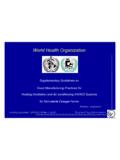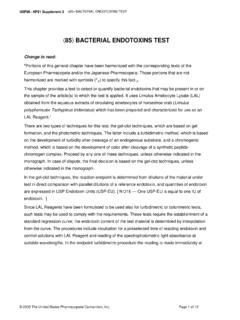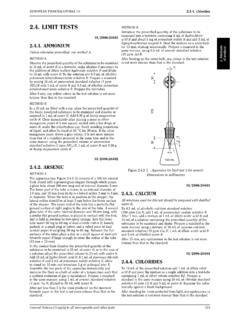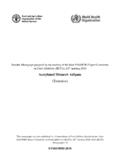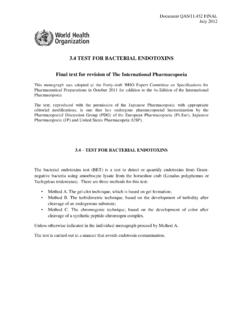Transcription of Type of an- Inactivator Concentration Comment …
1 EUROPEAN PHARMACOPOEIA Bacterial endotoxinsMaize gSodium gAgar, according to gelling g to gPurified water1000 mlHydrate the agar, dissolve by heating to boiling withcontinuous stirring. If necessary, adjust the pH so thatafter sterilisation it is Sterilise by heating in anautoclave at 121 C for 15 min. Allow to cool to 45-50 C;add, where necessary, gentamicin sulphate corresponding to20 mg of gentamicin base and pour into Petri R (Lactose monohydrate sulphite medium)Pancreatic digest of gYeast gSodium gLactose gCysteine gPurified water1000 mlDissolve, adjust to pH and fill to 8 ml in16 mm 160 mm tubes containing a small Durham by heating in an autoclave at 121 C for 15 min andstore at 4 use, heat the medium for 5 min in a water-bath andcool. Add to each tube ml of a 12 g/l solution ofsodiummetabisulphite Rand ml of a 10 g/l solution of ferricammonium citrate, both solutions being freshly preparedandfilteredthroughmembranes( m).
2 Agar medium S (R2A)Yeast gProteose gCasein gDipotassium hydrogen gMagnesium sulphate, gSodium gPurified water1000 mlAdjust the pH so that after sterilisation it is by heating in an autoclave at 121 C for 15 AGENTSN eutralising agents may be used to neutralise the activityof antimicrobial agents. They may be added to bufferedsodium chloride-peptone solution pH , preferably beforesterilisation. If utilised their efficacy and non-toxicity towardsmicro-organisms are typical neutralising fluid has the following composition:Polysorbate 8030 gLecithin (egg)3gHistidine hydrochloride1gPeptone (meat or casein)1gSodium gPotassium dihydrogen gDisodium hydrogen phosphate gPurified water1000 mlSterilise by heating in an autoclave at 121 C for 15 the solution has insufficient neutralising capacity theconcentration of polysorbate 80 or lecithin may be , the neutralisers mentioned in Table be Inactivators for antimicrobial agents to beadded to buffered sodium chloride-peptone solution pH of an-timicrobialagentInactivatorConcentrat ionCommentSodiumlaurilsulfate4g/lPolysor bate 80and lecithin30 g/l and 3 g/lPhenolicsEgg yolk5ml/l-50ml/lAdd aftersterilisation ofbuffered sodiumchloride-peptonesolution pH g/l - 5 g/lHalogensSodiumthiosulphate5g/lQuatern aryammoniumcompoundsEgg yolk5ml/l-50ml/lAdd aftersterilisation ofbuffered sodiumchloride-peptonesolution pH BACTERIAL ENDOTOXINSThe test for bacterial endotoxins is used to detect orquantify endotoxins of gram-negative bacterial originusing amoebocyte lysate from horseshoe crab (LimuluspolyphemusorTachypleus tridentatus).
3 There are3 techniques for this test: the gel-clot technique, whichis based on gel formation; the turbidimetric technique,based on the development of turbidity after cleavage of anendogenous substrate; and the chromogenic technique,based on the development of colour after cleavage of asynthetic peptide-chromogen :Method method: limit testMethod method: semi-quantitative testMethod kinetic methodMethod D. Chromogenic kinetic methodMethod E. Chromogenic end-point methodMethod end-point methodProceed by any of the 6 methods for the test. In the eventof doubt or dispute, the final decision is made based uponmethod A unless otherwise indicated in the test is carried out in a manner that avoids all glassware and other heat-stable apparatusin a hot-air oven using a validated process. A commonly usedminimum time and temperature is 30 minutes at 250 C. Ifemploying plastic apparatus, such as microtitre plates andpipette tips for automatic pipetters, use apparatus shownto be free of detectable endotoxin and of interfering effectsfor the : In this chapter, the term tube includes all types ofreceptacles, for example microtitre plate (1) Bacterial endotoxinsEUROPEAN PHARMACOPOEIA of the standard endotoxin stock solutionThe standard endotoxin stock solution is prepared froman endotoxin reference standard that has been calibratedagainst the International Standard, for exampleendotoxinstandard is expressed in International Units (IU).
4 Theequivalence in IU of the International Standard is stated bythe World Health : One International Unit (IU) of endotoxin is equal toone Endotoxin Unit ( ).Follow the specifications in the package leaflet and on thelabel for preparation and storage of the standard endotoxinstock of the standard endotoxin solutionsAfter vigorously mixing the standard endotoxin stocksolution, prepare appropriate serial dilutions of this solutionusing water for bacterial endotoxins test (water for BET).Use the solutions as soon as possible to avoid loss of activityby of the test solutionsPrepare the test solutions by dissolving or diluting activesubstances or medicinal products using water for substances or preparations may be more appropriatelydissolved or diluted in other aqueous solutions. If necessary,adjust the pH of the test solution (or dilution thereof) so thatthepHofthemixtureofthelysateandtests olutionfallswithin the pH range specified by the lysate usually applies to a product with a pH in the range of The pH may be adjusted by the use of acid, base or asuitable buffer, as recommended by the lysate and bases may be prepared from concentrates orsolids with water for BET in containers free of detectableendotoxin.
5 Buffers must be validated to be free of detectableendotoxin and interfering of the Maximum Valid DilutionThe Maximum Valid Dilution (MVD) is the maximumallowable dilution of a sample at which the endotoxin limitcan be determined. Determine the MVD using the followingformulae:Endotoxin limit: the endotoxin limit for active substancesadministered parenterally, defined on the basis of dose, isequal to:K=threshold pyrogenic dose of endotoxin perkilogram of body mass in a single hour period,M=maximum recommended dose of product perkilogram of body mass in a single hour endotoxin limit for active substancesadministered parenterally is specified in units suchas IU/ml, IU/mg, IU/Unit of biological activity, etc., of test solution: in mg/ml if the endotoxin limit is specified by mass(IU/mg), in Units/ml if the endotoxin limit is specified by unit ofbiological activity (IU/Unit), in ml/ml if the endotoxin limit is specified by volume(IU/ml).
6 =the labelled lysate sensitivity in the gel-clottechnique (IU/ml) or the lowest point usedin the standard curve of the turbidimetric orchromogenic TECHNIQUE (METHODS A AND B)The gel-clot technique allows detection or quantificationof endotoxins and is based on clotting of the lysate in thepresence of endotoxins. The Concentration of endotoxinsrequired to cause the lysate to clot under standard validity of the test, confirm the labelled lysate sensitivityand perform the test for interfering factors as describedunder1. Preparatory PREPARATORY TESTING(i) Confirmation of the labelled lysate sensitivityConfirm in 4 replicates the labelled sensitivity , expressedin IU/ml, of the lysate solution prior to use in the of the lysate sensitivity is carried out when anew batch of lysate is used or when there is any change inthe experimental conditions which may affect the outcomeof the standard solutions of at least 4 concentrationsequivalent to 2 , , and by diluting the standardendotoxin stock solution with water for a volume of the lysate solution with an equal volumeof 1 of the standard solutions (such as ml aliquots) ineach tube.
7 When single test vials or ampoules containinglyophilised lysate are employed, add solutions directly tothe vial or ampoule. Incubate the reaction mixture for aconstant period according to the recommendations of thelysatemanufacturer(usuallyat37 1 Cfor60 2min),avoiding vibration. Test the integrity of the gel: for tubes,take each tube in turn directly from the incubator and invertit through approximately 180 in one smooth motion. If afirm gel has formed that remains in place upon inversion,record the result as positive. A result is negative if an intactgel is not test is not valid unless the lowest Concentration of thestandard solutions shows a negative result in all end-point is the last positive result in the series ofdecreasing concentrations of endotoxin. Calculate the meanvalue of the logarithms of the end-point concentrations andthen the antilogarithm of the mean value using the followingexpression:Geometric mean end-point Concentration ==sum of the log end-point concentrations of thedilution series used,f=number of geometric mean end-point Concentration is the measuredsensitivity of the lysate solution (IU/ml).
8 If this is not lessthan and not more than 2 , the labelled sensitivity isconfirmed and is used in the tests performed with this lysate.(ii) Test for interfering factorsPrepare solutions A, B, C and D as shown in Table ,and use the test solutions at a dilution less than the MVD,not containing any detectable endotoxins, operating asdescribed under 1. Preparatory testing, (i) Confirmation ofthe labelled lysate the information section on general monographs (cover pages)EUROPEAN PHARMACOPOEIA Bacterial endotoxinsTable 1 SolutionEndotoxin Concentration / Solution towhich endotoxin is addedDiluentDilution factorInitial endotoxinconcentrationNumber of replicatesANone/Test solution---4B2 /Test solutionTest solution12482 1 4444C2 /Water for BETW ater for BET12482 1 2222 DNone/Water for BET---2 Solution A = solution of the preparation being examined that is free of detectable B = test for C = control of the labelled lysate D = negative control (water for BET).
9 The geometric mean end-point concentrations of solutions Band C are determined using the expression described in testing, (i) Confirmation of the labelled test for interfering factors is repeated when any changesare made to the experimental conditions that are likely test is not valid unless all replicates of solutions A andD show no reaction and the result of solution C less than and not greater than 2 , the test solutiondoes not contain interfering factors under the experimentalconditions used. Otherwise, the solution interferes with the preparation being examined interferes with the test ata dilution less than the MVD, repeat the test for interferingfactors using a greater dilution, not exceeding the MVD. Theuse of a more sensitive lysate permits a greater dilution ofthe preparation being examined and this may contribute tothe elimination of ,suchas filtration, neutralisation, dialysis or heat treatment.
10 Toestablish that the treatment chosen effectively eliminatesinterference without loss of endotoxins, repeat the test forinterfering factors using the preparation being examined towhich the standard endotoxin has been added and which hasthen been submitted to the chosen (METHODA)(i) ProcedurePrepare solutions A, B, C and D as shown in Table ,and perform the test on these solutions following theprocedure described under 1. Preparatory testing, (i)Confirmation of the labelled lysate Endotoxin Concentration / Solutionto which endotoxin is addedNumber of replicatesANone/Diluted test solution2B2 /Diluted test solution2C2 /Water for BET2 DNone/Water for BET2 Prepare solution A and solution B (positive product control)using a dilution not greater than the MVD and treatments asdescribed in 1. Preparatory testing, (ii) Test for interferingfactors. Solutions B and C (positive controls) contain thestandard endotoxin at a Concentration corresponding totwice the labelled lysate sensitivity.
